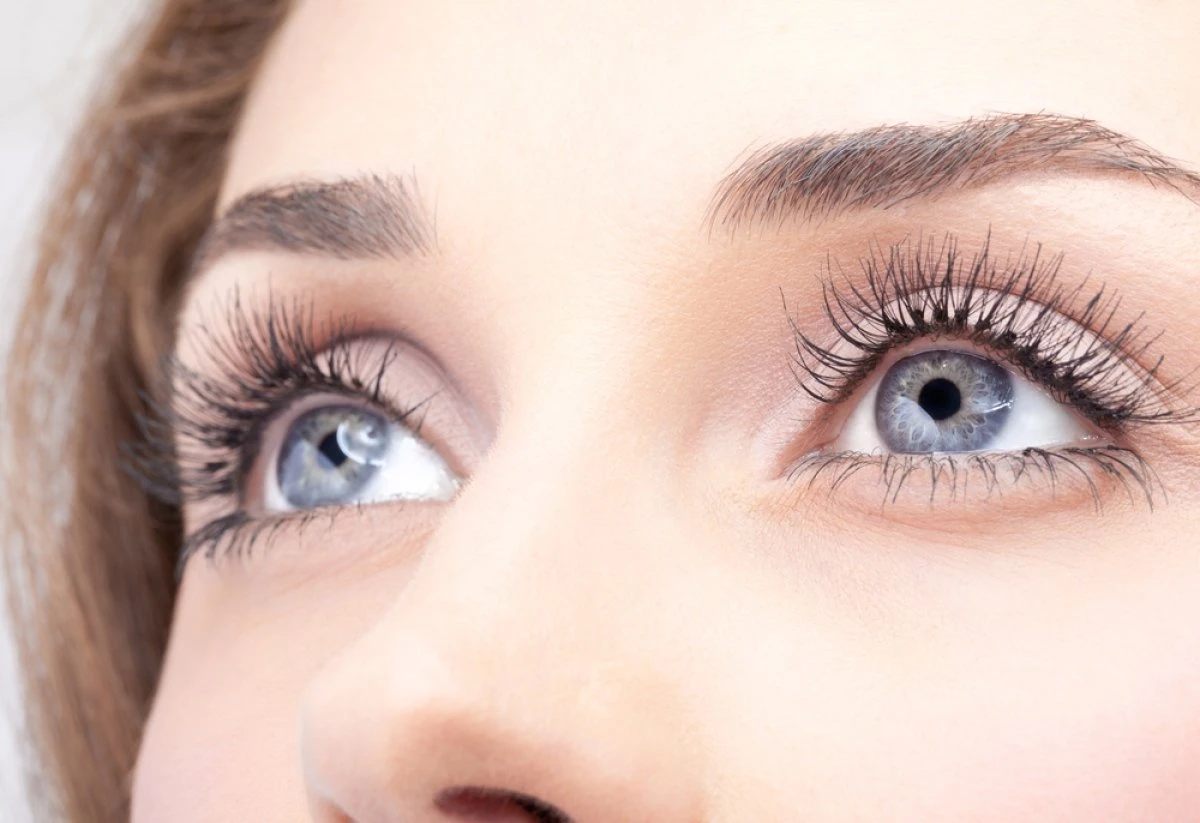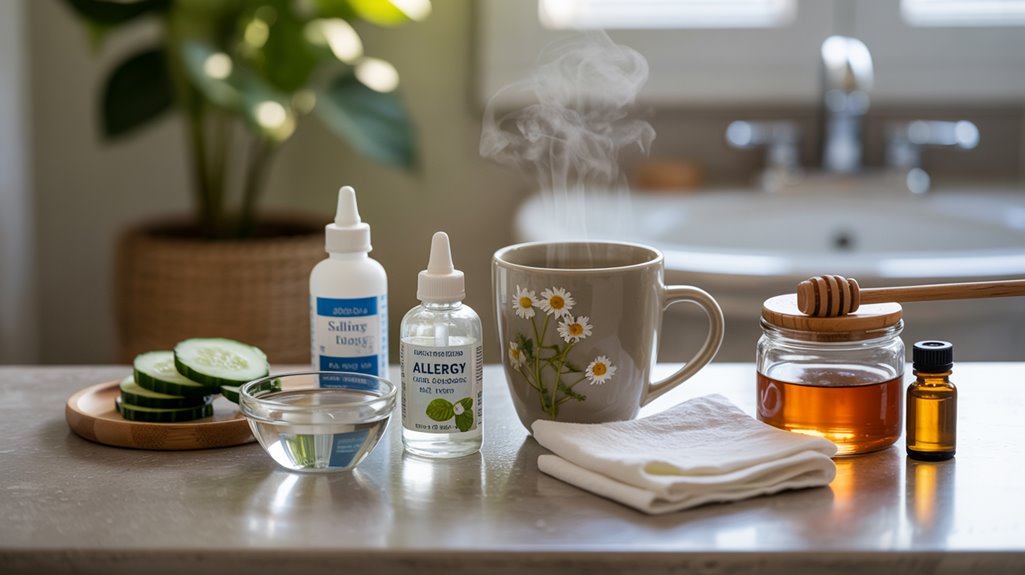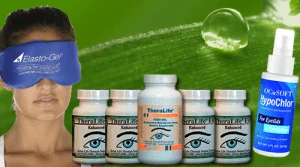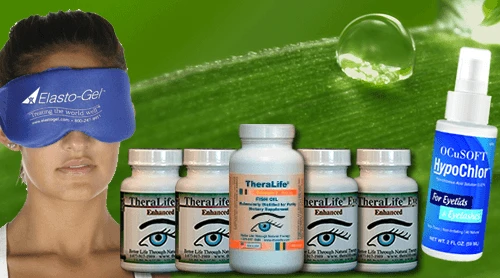To effectively manage watery eyes, consider the unique benefits of TheraLife’s products. TheraLife is the only company that offers oral eye treatment care, providing a distinct approach to eye health. Their products support tear film stability, enhance meibomian gland function, and maintain eye hygiene. Implementing TheraLife’s solutions can help reduce screen time effects, manage allergies, and maintain healthy indoor humidity levels, offering comprehensive control over excessive tearing. By choosing TheraLife, customers gain access to innovative solutions that target the root causes of eye discomfort, ensuring long-term relief and improved eye health.
Powerful Oral Treatment for Watery Eyes – From Inside Out
Add To Cart
Key Takeaways
- Avoid common triggers like pollen, smoke, and dust by using air purifiers and wearing protective eyewear.
- Use preservative-free artificial tears or lubricating eye drops to soothe and stabilize the tear film.
- Apply a warm compress to eyelids regularly to support healthy oil gland function and reduce irritation.
- Practice frequent handwashing and replace towels and pillowcases to maintain good eye hygiene.
- Follow the 20-20-20 rule and take regular screen breaks to reduce digital eye strain and excessive tearing.
Identify and Avoid Triggers

Although watery eyes can stem from several causes, pinpointing and minimizing exposure to specific triggers remains an essential first step in management. You’ll need to systematically assess environmental factors—such as pollen, dust, smoke, or temperature fluctuations—that may irritate the ocular surface and provoke excessive tearing.
Identifying these allergens or irritants allows you to alter your surroundings, for example, by using air purifiers or avoiding outdoor exposure during high pollen counts. Additionally, evaluate personal habits that may contribute to symptoms. Rubbing your eyes, prolonged screen time, and poor facial hygiene can exacerbate irritation and tear production. Wearing protective eyewear can act as a barrier against irritants like wind and dust, significantly reducing eye discomfort and excessive tearing.
Use Artificial Tears or Lubricating Eye Drops
When your eyes produce excess tears due to irritation or dryness, artificial tears or lubricating eye drops can provide immediate symptomatic relief by stabilizing the tear film and reducing ocular surface friction. These over-the-counter solutions work by supplementing your natural tear layer, thereby minimizing evaporative loss and soothing the conjunctiva. Choose preservative-free artificial tears if you need to use them frequently, as preservatives can sometimes worsen ocular surface irritation. Lubricating drops containing carboxymethylcellulose or hyaluronic acid are clinically proven to enhance moisture retention and improve ocular comfort. Administer the drops as directed, usually one to two drops per eye as needed. For MGD and other related conditions, warm compresses and eye hygiene may also be beneficial. Don’t touch the dropper tip to your eye to avoid contamination. If you don’t notice improvement, consult an eye care professional for further evaluation.
Apply a Warm Compress
You can reduce ocular irritation by applying a warm compress, as localized heat promotes meibomian gland function and improves tear film stability. To guarantee safety, use a clean, lint-free cloth soaked in warm (not hot) water, and apply it gently to your closed eyelids for 5–10 minutes. Opt for compress materials like sterile gauze pads or commercially available eye masks that maintain consistent, therapeutic warmth. Regularly applying a warm compress helps prevent blockage of meibomian oil glands, which can lead to conditions like chalazion.
How Heat Eases Irritation
Because many believe a warm compress can alleviate eye irritation and reduce excess tearing, it’s important to recognize that current clinical evidence doesn’t support the use of heat for treating watery eyes.
While heat therapy is commonly promoted for its soothing effects, especially in conditions like blepharitis or meibomian gland dysfunction, scientific studies haven’t demonstrated its effectiveness for excessive tearing or lacrimation.
You may perceive temporary comfort from the application of warmth due to increased local blood flow and mild relaxation of periocular muscles; however, these effects don’t address the underlying causes of watery eyes.
Warm compresses are an effective first-line treatment for chalazion, facilitating drainage of gland contents and reducing inflammation in conditions like chalazion.
Current ophthalmological guidelines don’t recommend heat therapy as a first-line intervention for tearing, emphasizing instead targeted treatments based on the specific etiology.
Consult a healthcare provider for evidence-based management.
Steps for Safe Application
Although current research doesn’t support heat therapy as an effective remedy for watery eyes, many individuals still choose to apply warm compresses for perceived comfort. To guarantee safety, prioritize safe product selection by choosing a clean, lint-free cloth or commercially available eye compress specifically designed for ophthalmic use. Avoid any materials containing fragrances or harsh chemicals, as these may exacerbate irritation. For proper application, soak the compress in warm—not hot—water, then wring out excess liquid to prevent dripping. Test the temperature on your wrist to safeguard against thermal injury. Gently place the compress over your closed eyelids for 5 to 10 minutes, ensuring the area remains clean to reduce infection risk. For individuals with eyelid conditions like Blepharitis, using an all-natural eye wash can help maintain eyelid hygiene and comfort. Repeat as needed, always inspecting the compress for cleanliness before each use.
Best Compress Materials
Several types of materials offer perfect safety and efficacy when selecting a compress for warm application to the eyes. When you’re choosing fabric choices, prioritize clean, lint-free cotton or microfiber cloths, as these reduce the risk of irritation or infection. Medical-grade gauze is another excellent option, providing a sterile barrier that retains warmth and conforms well to the orbital area. Avoid synthetic fabrics, which may not retain heat effectively or could trigger allergic reactions. It’s crucial to differentiate between warm and cold compress needs—while cold compress materials can include gel packs or chilled cotton, warm compresses work best with moisture-retaining fabrics. Always verify the compress is comfortably warm, not hot, to prevent thermal injury. Replace and launder materials regularly to maintain ideal ocular hygiene and therapeutic benefit. Consistent application of heat is crucial for better results; multiple applications per day enhance effectiveness.
Practice Good Eye Hygiene
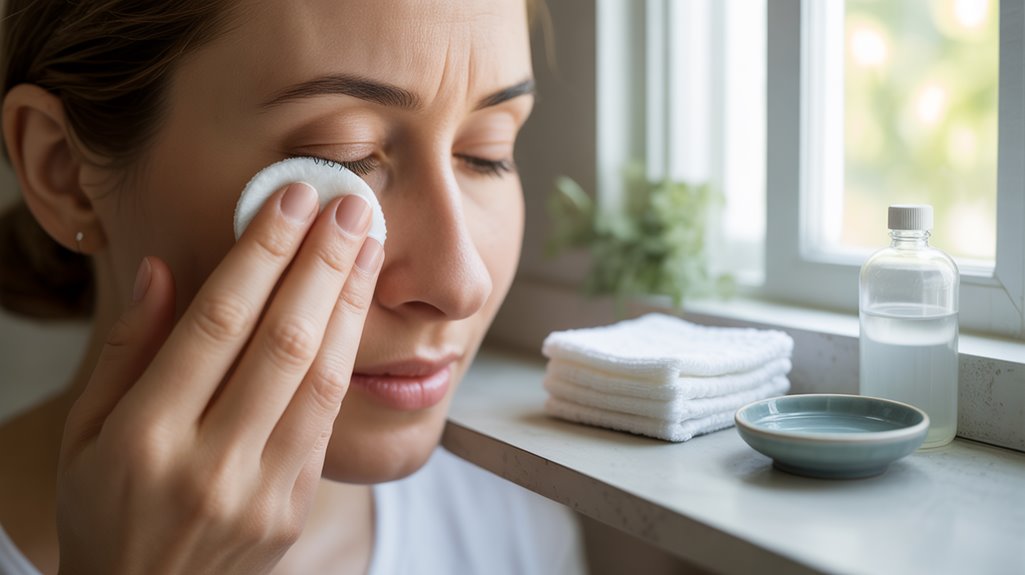
Maintaining proper eye hygiene plays an essential role in managing watery eyes, as it helps minimize exposure to irritants and potential pathogens. You should prioritize consistent eye care and integrate effective hygiene practices into your daily routine. For example, cleanse your eyelids with a sterile, non-irritating solution—this removes debris and reduces bacterial load, lowering your risk of blepharitis and conjunctivitis. Always wash your hands thoroughly before touching your eyes or handling contact lenses. Replace towels and pillowcases regularly to prevent microbial accumulation. These evidence-based strategies can help control excessive tearing by reducing inflammation and allergic reactions. Incorporating omega-3 fatty acids into your diet may also alleviate ocular irritation symptoms and support overall eye health.
| Hygiene Practice | Clinical Benefit |
|---|---|
| Lid scrubs | Decreases bacterial colonization |
| Handwashing | Limits transmission of pathogens |
| Clean linens | Reduces allergen/microbe exposure |
| Avoid eye rubbing | Prevents irritation or infection |
Limit Screen Time and Take Breaks
Limiting your screen time and taking regular breaks can reduce digital eye strain, which is a common cause of excessive tearing. You should follow the 20-20-20 rule—every 20 minutes, look at something 20 feet away for 20 seconds—to help maintain tear film stability. Blinking frequently and adjusting your screen brightness to match ambient light can further support ideal ocular surface health. Incorporating omega-3 fatty acids into your diet, found in oily fish and flaxseeds, can also aid in maintaining healthy tear production and ocular surface.
Follow the 20-20-20 Rule
Although digital devices have become integral to daily activities, prolonged screen exposure can disrupt the normal tear film and exacerbate watery eyes due to reduced blink frequency.
To mitigate these effects, you should implement the 20-20-20 Rule: every 20 minutes, shift your gaze to an object at least 20 feet away for 20 seconds. This evidence-based practice helps alleviate eye strain and visual fatigue by encouraging regular breaks from close-up focus, reducing accommodative stress, and allowing your ocular surface to recover.
Clinical studies show that periodic visual rest counteracts the negative impact of sustained digital device use, particularly among individuals prone to watery eyes. Additionally, for those suffering from chronic dry eyes, underactive tear production is a key issue that can be addressed with products like TheraLife Eye, which target the root cause rather than offering temporary relief through eye drops.
Blink Frequently for Comfort
When you consciously increase your blink frequency, you replenish the tear film that protects and lubricates your ocular surface, thereby reducing the likelihood of reflex tearing and discomfort.
Extended screen use often leads to a decreased blink rate, which compromises tear film stability and exacerbates watery eyes. Incorporating blink exercises and scheduled eye relaxation breaks can counteract this effect. It’s important to note that contact lens wearers report higher incidence of dry eye symptoms, which can be mitigated by proper lens hygiene and hydrating solutions.
To optimize ocular comfort and minimize symptoms, consider the following:
- Practice deliberate blinking: Every 20 minutes, close your eyes fully and gently for 2 seconds, then squeeze shut for another 2 seconds before reopening.
- Limit continuous screen exposure: Take structured breaks to facilitate natural tear distribution and ocular surface recovery.
- Engage in periodic eye relaxation: Look away from digital devices and focus on distant objects, encouraging spontaneous blinking and reducing ocular strain.
Adjust Screen Brightness
Complementing frequent blinking, managing your digital environment plays a pivotal role in controlling watery eyes. Excessive screen time can lead to digital eye strain, which exacerbates tearing by destabilizing the tear film.
You should optimize your screen’s brightness adjustment to match the ambient lighting; overly bright or dim screens can increase ocular surface irritation. Reducing screen glare by positioning monitors away from direct light sources or using anti-glare filters helps minimize visual discomfort and reflex tearing.
It’s also clinically advisable to follow the 20-20-20 rule: every 20 minutes, look at something 20 feet away for 20 seconds. Limiting screen time and integrating regular breaks support better tear film stability, reducing the risk of reflex tearing and promoting ocular surface health.
Try Allergy Medications
Allergy medications, such as oral antihistamines or intranasal corticosteroids, often target symptoms like sneezing, itching, or nasal congestion but generally don’t provide significant relief for watery eyes unless allergic conjunctivitis is present.
If your watery eyes accompany other allergy symptoms—such as ocular itching or redness—consider discussing targeted medication options with your healthcare provider. Evidence suggests that when allergic conjunctivitis is the underlying cause, pharmacologic therapy can be effective.
Here are three clinically supported medication options to address allergy-related watery eyes:
- Oral antihistamines – Reduce systemic allergy symptoms but may sometimes worsen ocular dryness.
- Antihistamine eye drops – Act locally to relieve itching and decrease tear overproduction associated with allergic conjunctivitis.
- Intranasal corticosteroids – Alleviate nasal symptoms, which may indirectly improve related ocular complaints.
Always consult a clinician before starting new medications.
Maintain Proper Humidity Indoors
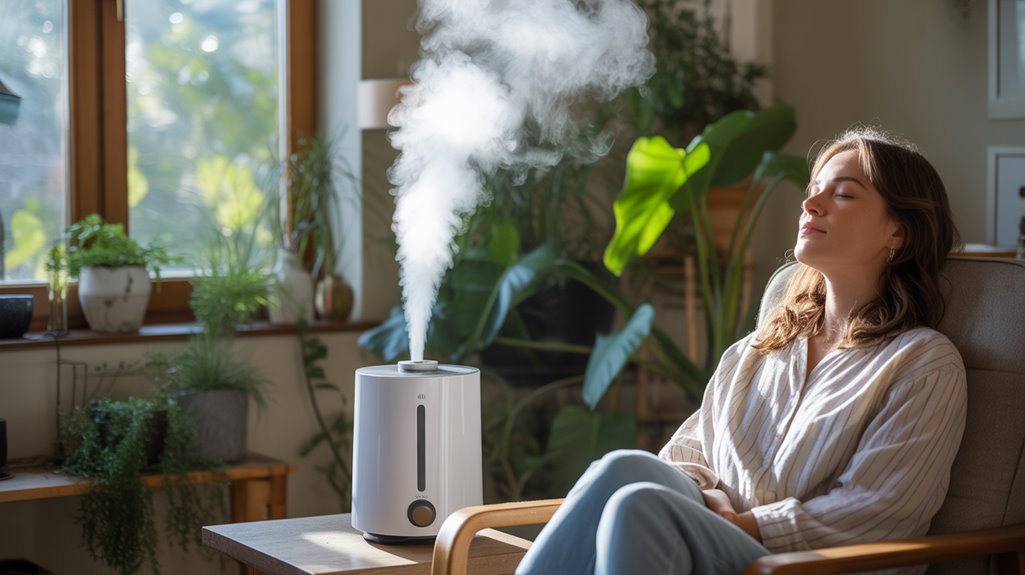
Although environmental factors often go unnoticed, maintaining perfect indoor humidity can greatly influence tear film stability and ocular surface health.
Low moisture levels indoors accelerate tear evaporation, contributing to excessive reflex tearing and ocular discomfort. Aim to keep indoor humidity between 40% and 60%, as this range supports ideal mucin and lipid layer integrity, reducing irritation and watering.
Humidifiers are effective tools, but you can also use indoor plants to naturally regulate moisture levels. Plants like peace lilies and spider plants release water vapor, enhancing ambient humidity.
Monitor humidity with a hygrometer to guarantee consistency, particularly during winter when heating systems dry the air.
Powerful Oral Treatment for Watery Eyes – From Inside Out
Add To Cart
Frequently Asked Questions
When Should I See a Doctor for Watery Eyes?
If you notice persistent watery eyes, especially with redness, pain, or vision changes, you should see a doctor.
Eye allergies or eye infections often cause excessive tearing, but if symptoms last over a week or worsen, they may indicate serious conditions like conjunctivitis or blocked tear ducts.
Don’t ignore discharge, light sensitivity, or swelling, as they could require prompt treatment.
Early evaluation helps prevent complications and guarantees you get the right care.
Can Certain Foods Help Reduce Watery Eyes?
Did you know that up to 20% of adults experience chronic watery eyes linked to diet and inflammation?
You can reduce symptoms by incorporating nutrient rich foods, such as leafy greens and fatty fish, which contain anti inflammatory ingredients like omega-3 fatty acids and vitamin A.
Evidence shows these nutrients stabilize tear film and decrease ocular surface irritation.
Opt for foods with antioxidants, as they help combat oxidative stress and support ideal eye health.
Are Children Prone to Watery Eyes More Than Adults?
You might notice children experience watery eyes more often than adults.
In child eye care, clinicians observe that immature tear ducts, higher exposure to environmental factors, and frequent viral infections play significant roles.
Children’s immune systems react more strongly to allergy triggers like pollen or dust, increasing lacrimation.
Studies show that pediatric patients commonly present with epiphora due to these factors, so monitoring and minimizing exposure to known allergens is essential for effective management.
Is Watery Eye a Symptom of an Underlying Illness?
When your eyes feel like Niagara Falls, you can’t ignore the possibility of an underlying illness. Watery eyes often scream for attention, acting as classic allergies symptoms or red flags for eye infections.
You might experience excessive tearing due to irritants, conjunctivitis, or even blocked tear ducts. Clinically, it’s essential to assess for systemic conditions—like autoimmune disorders—that can manifest with ocular symptoms.
Don’t dismiss persistent tearing; it often points to deeper health concerns.
Can Contact Lenses Cause Excessive Tearing?
Yes, you can experience excessive tearing from contact lenses if you neglect contact lens hygiene or encounter eye allergy triggers.
Poor hygiene allows debris and pathogens to accumulate, irritating the ocular surface and stimulating reflex tearing.
Additionally, allergens trapped beneath the lens can provoke conjunctival inflammation, leading to watery eyes.
Ensuring proper disinfection, replacing lenses as recommended, and minimizing exposure to allergens can greatly reduce the incidence of excessive tearing related to contact lens wear.
Powerful Oral Treatment for Watery Eyes – From Inside Out
Add To Cart
Conclusion
If you’re looking for effective solutions to manage watery eyes, TheraLife offers a unique approach that sets it apart. Known for being the sole provider of oral eye treatment care, TheraLife’s products cater to various eye conditions with a focus on internal, holistic healing. By incorporating TheraLife’s clinically proven solutions, such as their comprehensive range of eye health supplements, you can target the root causes of excessive tearing and achieve lasting relief. Unlike traditional methods that focus solely on external treatments, TheraLife enhances the body’s natural ability to balance eye moisture from within. Take control of your eye health with TheraLife and ensure your tears are reserved for truly Oscar-worthy moments.
References
- 1.
- 2.
- Nemet AY. The Etiology of Epiphora: A Multifactorial Issue. Semin Ophthalmol. 2016;31(3):275-9. [PubMed]
- 3.
- Shen GL, Ng JD, Ma XP. Etiology, diagnosis, management and outcomes of epiphora referrals to an oculoplastic practice. Int J Ophthalmol. 2016;9(12):1751-1755. [PMC free article] [PubMed]
- 4.
- Patel J, Levin A, Patel BC. StatPearls [Internet]. StatPearls Publishing; Treasure Island (FL): Aug 7, 2023. Epiphora. [PubMed]
- 5.
- Gurnani B, Kaur K. StatPearls [Internet]. StatPearls Publishing; Treasure Island (FL): Jun 11, 2023. Bacterial Keratitis. [PubMed]
- 6.
- Basu S. Seeing through tears: Understanding and managing dry eye disease. Indian J Ophthalmol. 2023 Apr;71(4):1065-1066. [PMC free article] [PubMed]
- 7.
- Icasiano E, Latkany R, Speaker M. Chronic epiphora secondary to ocular rosacea. Ophthalmic Plast Reconstr Surg. 2008 May-Jun;24(3):249. [PubMed]
- 8.
- 9.
- Tse DT, Erickson BP, Tse BC. The BLICK mnemonic for clinical-anatomical assessment of patients with epiphora. Ophthalmic Plast Reconstr Surg. 2014 Nov-Dec;30(6):450-8. [PubMed]
- 10.
- Webber NK, Setterfield JF, Lewis FM, Neill SM. Lacrimal canalicular duct scarring in patients with lichen planus. Arch Dermatol. 2012 Feb;148(2):224-7. [PubMed]
- 11.
- Portelinha J, Passarinho MP, Costa JM. Neuro-ophthalmological approach to facial nerve palsy. Saudi J Ophthalmol. 2015 Jan-Mar;29(1):39-47. [PMC free article] [PubMed]
- 12.
- Zhang Y, Zeng C, Chen N, Liu C. Lacrimal ductal cyst of the medial orbit: a case report. BMC Ophthalmol. 2020 Sep 24;20(1):380. [PMC free article] [PubMed]
- 13.
- Kim JS, Liss J. Masses of the Lacrimal Gland: Evaluation and Treatment. J Neurol Surg B Skull Base. 2021 Feb;82(1):100-106. [PMC free article] [PubMed]
- 14.
- Lievens CW, Rayborn E. Tribology and the Ocular Surface. Clin Ophthalmol. 2022;16:973-980. [PMC free article] [PubMed]
- 15.
- Al Saleh A, Vargas JM, Al Saleh AS. Supernumerary lacrimal puncta: Case series. Saudi J Ophthalmol. 2020 Oct-Dec;34(4):328-330. [PMC free article] [PubMed]

